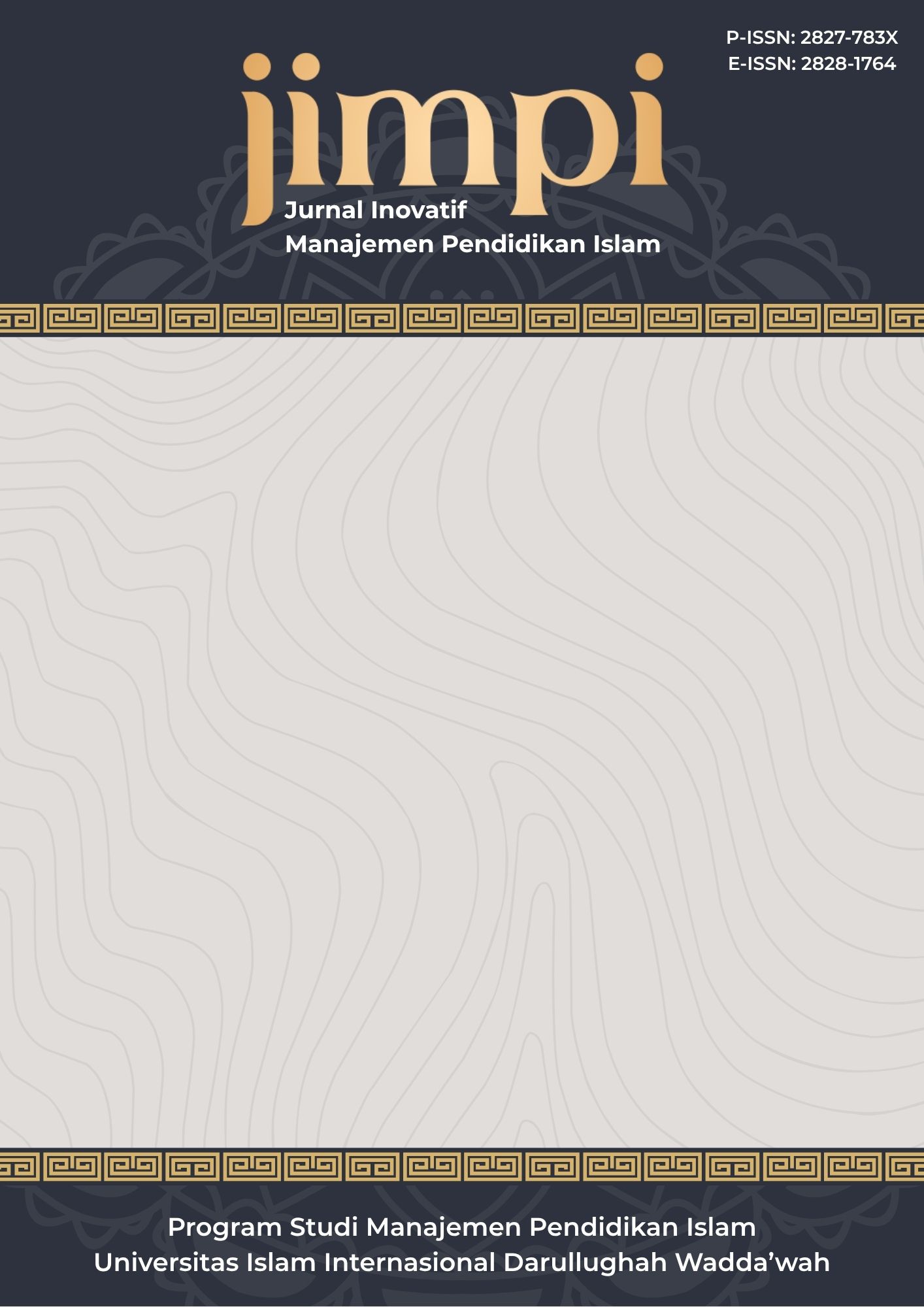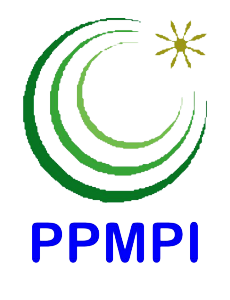Unleashing Excellence: Integrated Facility Management, Organizational Communication, and Education Service Quality
DOI:
https://doi.org/10.38073/jimpi.v3i1.1461Keywords:
Education Service Quality, Facility Management, Organizational CommunicationAbstract
The study aims to examine the influence of facility management and organizational communication on the quality of educational services using a quantitative research method with a survey approach. The sample size consists of 35 respondents. Data collection was conducted through questionnaires, and multiple regression analysis was employed for data analysis. The results indicate a significant positive effect of facility management on the quality of educational services (T-statistic = 2.779, p < 0.05). Similarly, organizational communication was found to have a significant positive impact on service quality (T-statistic = 3.582, p < 0.05). Furthermore, the combined effect of facility management and organizational communication on the quality of educational services was found to be significant (F-value = 8.850, p < 0.05). These findings highlight the importance of facilities and infrastructure in delivering quality services and emphasize the crucial role of effective communication in service implementation. The study suggests that institutional managers should prioritize the enhancement of facilities and infrastructure as a policy priority and consider effective communication skills as a prerequisite for recruiting professional educators.
Downloads
References
Allison, Safwaan Zamakda. “Islamic Educational Provisions in South Korea and Indonesia: A Comparison.” Journal of Islamic Education Students 3, no. 1 (2023): 50–61. http://dx.doi.org/10.31958/jies.v3i1.8772.
Asiyai, Romina Ifeoma. “Best Practices for Quality Assurance in Higher Education: implications for Educational Administration.” International Journal of Leadership in Education 25, no. 5 (3 September 2022): 843–54. https://doi.org/10.1080/13603124.2019.1710569.
Caldwell, Brian John. “Impact of School Autonomy on Student Achievement: Cases from Australia.” International Journal of Educational Management 30, no. 7 (12 September 2016): 1171–87. https://doi.org/10.1108/IJEM-10-2015-0144.
Dasgupta, Basab, Ambar Narayan, dan Emmanuel Skoufias. “Measuring the Quality of Education and Health Services: The Use of Perception Data from Indonesia.” World Bank Policy Research Working Paper, no. 5033 (2009).
Demir, Ahmet, Lubna Maroof, Noor Us Sabbah Khan, dan Bayad Jamal Ali. “The Role of E-service Quality in Shaping Online Meeting Platforms: a case Study from Higher Education Sector.” Journal of Applied Research in Higher Education 13, no. 5 (13 Desember 2021): 1436–63. https://doi.org/10.1108/JARHE-08-2020-0253.
Dewi, Citra, Desrio Windoro, dan Dwi Naomi Pura. “Management of Physical Education Facilities and Infrastructure.” Journal of Education Technology 5, no. 2 (20 Juni 2021). https://doi.org/10.23887/jet.v5i2.34450.
Duarte, Nelson, dan Ricardo Vardasca. “Literature Review of Accreditation Systems in Higher Education.” Education Sciences 13, no. 6 (7 Juni 2023): 582. https://doi.org/10.3390/educsci13060582.
Eze, Sunday C., Vera C. A. Chinedu-Eze, Clinton K. Okike, dan Adenike O. Bello. “Factors Influencing the Use of e-Learning Facilities by Students in a Private Higher Education Institution (HEI) in a Developing Economy.” Humanities and Social Sciences Communications 7, no. 1 (27 Oktober 2020): 133. https://doi.org/10.1057/s41599-020-00624-6.
Frymier, Ann Bainbridge. “Students’ Classroom Communication Effectiveness.” Communication Quarterly 53, no. 2 (3 Mei 2005): 197–212. https://doi.org/10.1080/01463370500089896.
Goodwin, Robin, dan Sophie Giles. “Social Support Provision And Cultural Values In Indonesia And Britain.” Journal of Cross-Cultural Psychology 34, no. 2 (27 Maret 2003): 240–45. https://doi.org/10.1177/0022022102250227.
Granvik Saminathen, Maria, Sara Brolin Låftman, Ylva B. Almquist, dan Bitte Modin. “Effective Schools, School Segregation, and the Link with School Achievement.” School Effectiveness and School Improvement 29, no. 3 (3 Juli 2018): 464–84. https://doi.org/10.1080/09243453.2018.1470988.
Joshi, Jyotsna. “Competitiveness, Manufacturing and Infrastructure: The Asian Paradigm.” Journal of Development Policy and Practice 6, no. 1 (30 Januari 2021): 78–107. https://doi.org/10.1177/2455133321994210.
Khatoon, Sadia, Xu Zhengliang, dan Hamid Hussain. “The Mediating Effect of Customer Satisfaction on the Relationship Between Electronic Banking Service Quality and Customer Purchase Intention: Evidence From the Qatar Banking Sector.” SAGE Open 10, no. 2 (24 April 2020): 215824402093588. https://doi.org/10.1177/2158244020935887.
Khurniawan, Arie Wibowo, Illah Sailah, Pudji Muljono, Bambang Indriyanto, dan M. Syamsul Maarif. “The Improving of Effectiveness School-Based Enterprise: A Structural Equation Modeling in Vocational School Management.” International Journal of Evaluation and Research in Education (IJERE) 10, no. 1 (1 Maret 2021): 161. https://doi.org/10.11591/ijere.v10i1.20953.
Lane, Shelley D. Interpersonal Communication: Competence and Contexts. Routledge, 2016.
Lucander, Henriette, dan Cecilia Christersson. “Engagement for Quality Development in Higher Education: a Process for Quality Assurance of Assessment.” Quality in Higher Education 26, no. 2 (3 Mei 2020): 135–55. https://doi.org/10.1080/13538322.2020.1761008.
Mulyono, Hardi, Arief Hadian, Nelvitia Purba, dan Rudy Pramono. “Effect of Service Quality Toward Student Satisfaction and Loyalty in Higher Education.” The Journal of Asian Finance, Economics and Business 7, no. 10 (31 Oktober 2020): 929–38. https://doi.org/10.13106/jafeb.2020.vol7.no10.929.
Nurmayuli, Nurmayuli. “The Management of Facilities and Infrastructures in Educational Institution.” Idarah (Jurnal Pendidikan dan Kependidikan) 6, no. 1 (30 Oktober 2022): 87–102. https://doi.org/10.47766/idarah.v6i1.92.
Prasetyo, Muhammad Anggung Manumanoso, dan Wirdatul Kifla. “Participatory Leadership and Teacher Motivation in Improving School Quality.” EDUKASI : Jurnal Pendidikan Islam (e-Journal) 11, no. 2 (2023): 214–29. https://doi.org/10.54956/edukasi.v11i2.387.
Prasetyo, Muhammad Anggung Manumanoso, dan Agus Salim Salabi. “School Effectiveness: Institutional Benchmarking for Vocational High School Management.” Jurnal Penelitian dan Pengembangan Pendidikan 7, no. 3 (31 Desember 2023): 474–83. https://doi.org/10.23887/jppp.v7i3.57587.
Prasetyo, Muhammad Anggung Manumanoso, dan Sukatin Sukatin. “Aspek Psikologis Organisasi Pendidikan Efektif.” ITQAN: Jurnal Ilmu-Ilmu Kependidikan 12, no. 1 (2021): 83–102. https://doi.org/10.47766/itqan.v12i1.182.
Rizky, Diannisa, Neti Karnati, dan Supadi Supadi. “Management of Educational Facilities and Infrastructure in Islamic Junior High School.” Journal of Education Research and Evaluation 6, no. 1 (22 Februari 2022): 26–35. https://doi.org/10.23887/jere.v6i1.37070.
Sagala, Syaiful, Wildansyah Lubis, dan Gaffar Hafiz Sagala. “Canonical Correlation between Principal Leadership and School Capacity.” International Journal of Management in Education 13, no. 3 (2019): 256. https://doi.org/10.1504/IJMIE.2019.100413.
Sartika, Didi. “Perencanaan Strategi Pemasaran Jasa Pendidikan Sekolah Tinggi Ilmu Tarbiyah (STIT) Simeulue Aceh Melalui Pendekatan Bauran Pemasaran (Marketing Mix).” Idarah (Jurnal Pendidikan dan Kependidikan) 3, no. 2 (15 Desember 2019): 1–15. https://doi.org/10.47766/idarah.v3i2.557.
Seyfried, Markus, dan Philipp Pohlenz. “Assessing Quality Assurance in Higher Education: Quality Managers’ Perceptions of Effectiveness.” European Journal of Higher Education 8, no. 3 (3 Juli 2018): 258–71. https://doi.org/10.1080/21568235.2018.1474777.
Siregar, Fauzan Ahmad, Lailatul Usriyah, dan ... “Peranan Komunikasi Organisasi dalam Manajemen Konflik.” Idarah (Jurnal Pendidikan dan Kependidikan) 5, no. 2 (31 Desember 2021): 163–74. https://doi.org/10.47766/idarah.v5i2.147.
Subandi, Subandi, dan Muda Setia Hamid. “Student Satisfaction, Loyalty, and Motivation as Observed from The Service Quality.” Journal of Management and Islamic Finance 1, no. 1 (17 Juni 2021): 136–53. https://doi.org/10.22515/jmif.v1i1.3552.
Sumintono, Bambang, Elslee Y.A. Sheyoputri, Na Jiang, Ifa H. Misbach, dan Jumintono. “Becoming a Principal in Indonesia: Possibility, Pitfalls and Potential.” Asia Pacific Journal of Education 35, no. 3 (3 Juli 2015): 342–52. https://doi.org/10.1080/02188791.2015.1056595.
Sutrisno, Sutrisno, Hayati Hayati, Nanda Saputra, Syamsul Arifin, dan Ari Kartiko. “The Influence of The Head of Madrasah and Infrastructure Facilities on The Quality of Education Through Teacher Competence.” Tafkir: Interdisciplinary Journal of Islamic Education 4, no. 2 (13 Juni 2023): 274–88. https://doi.org/10.31538/tijie.v4i2.423.
Uline, Cynthia L. “Educational Facility Management.” Dalam Educational Facility Management. Routledge, 2022. https://doi.org/10.4324/9781138609877-REE69-1.
Weber, Ellen, Eva‐Helen Krehl, dan Marion Büttgen. “The Digital Transformation Leadership Framework: Conceptual and Empirical Insights into Leadership Roles in Technology‐Driven Business Environments.” Journal of Leadership Studies 16, no. 1 (28 Juni 2022): 6–22. https://doi.org/10.1002/jls.21810.
Yansyah, Medi. “Effectiveness of Teacher Performance Management in the Implementation of Student Learning.” Journal Corner of Education, Linguistics, and Literature 1, no. 4 (5 Februari 2022): 227–34.
Yulius, Mellky. “Strategi meningkatkan mutu pendidikan melalui manajemen sarana dan prasarana pada smk negeri 1 singkawang.” Jurnal Ilmiah Kependidikan XIII, no. 2 (2020): 246–55. https://doi.org/DOI: 10.30595/jkp.v13i2.6982.
Downloads
Published
How to Cite
Issue
Section
License
Copyright (c) 2024 Sarita Mentari, Muhammad Anggung Manumanoso Prasetyo

This work is licensed under a Creative Commons Attribution-ShareAlike 4.0 International License.








